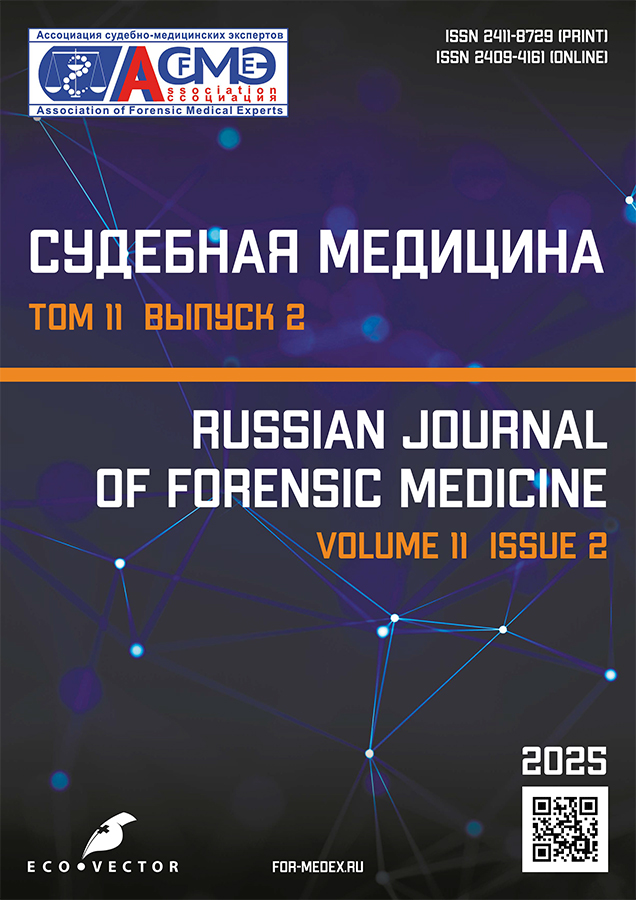死产案件中开展多专家委员会法医鉴定时组织形态学研究的作用
- 作者: Berlay M.V.1, Kildyushov E.M.2, Fedko I.I.2, Avanesyan H..2, Borschevskaya V.N.2, Zolotukhina E.A.2, Karpov S.M.2
-
隶属关系:
- The Russian National Research Medical University named after N.I. Pirogov
- Stavropol State Medical University
- 期: 卷 11, 编号 2 (2025)
- 页面: 112-122
- 栏目: 原创研究
- ##submission.dateSubmitted##: 06.10.2024
- ##submission.dateAccepted##: 09.06.2025
- ##submission.datePublished##: 27.08.2025
- URL: https://for-medex.ru/jour/article/view/16196
- DOI: https://doi.org/10.17816/fm16196
- EDN: https://elibrary.ru/IOTFEC
- ID: 16196
如何引用文章
详细
论证:俄罗斯联邦侦查机关在开展与产科医疗救治质量不佳相关的核查措施和刑事案件侦查时,其程序方法中包括委托实施由多名专家共同进行的委员会法医鉴定。对归档尸体解剖材料和胎盘实施法医组织学检查,是根据案件材料在胎儿宫内死亡案件中开展多专家委员会法医鉴定的重要环节。
目的:分析死产案件中的多专家委员会法医鉴定,并根据现代科学观点明确对归档尸检材料和胎盘进行法医组织学检查的必要性。
方法:在俄罗斯Stavropol Krai “Territorial Bureau of Forensic Medical Examination”复杂鉴定科的档案库中,开展了一项单中心、横断面、抽样的观察性研究。纳入标准为:在产前期和产时胎儿宫内死亡案件中开展的多专家委员会法医鉴定。
结果:纳入研究的胎儿宫内死亡案件多专家委员会法医鉴定共有68例(n=68),时间范围为2015年1月1日至2022年12月31日。其中,79.4%(n=54)由俄罗斯联邦侦查委员会侦查员委托,16.2%(n=11)由俄罗斯联邦内务部所属部门的侦查员/调查员/刑警委托,4.4%(n=3)由法官委托。在86.7%的案件中,此类鉴定是在核查材料框架内开展的。死产原因中,57.4%(n=39)为产前期胎儿死亡,39.73%(n=27)为产时胎儿死亡,2.9%(n=2)为先天性发育异常。在胎儿宫内死亡案件的多专家委员会法医鉴定中,97.1%(n=66)的病例中,法医组织学专家对尸检材料和胎盘进行了法医组织学检查。
结论:分析表明,39.1%的产科—妇科方向多专家委员会法医鉴定与死产相关。为提高此类鉴定的质量,有必要对尸检材料和胎盘进行法医组织学检查。完善死产案件中多专家委员会法医鉴定的方法学,是法医专家、病理解剖学家、产科医生及新生儿科医生跨学科合作的一项重要任务。
全文:
作者简介
Margarita V. Berlay
The Russian National Research Medical University named after N.I. Pirogov
编辑信件的主要联系方式.
Email: berlay_mv@mail.ru
ORCID iD: 0000-0002-5809-8480
SPIN 代码: 3676-6025
MD, Cand. Sci. (Medicine)
俄罗斯联邦, MoscowEvgeny M. Kildyushov
Stavropol State Medical University
Email: kem1967@bk.ru
ORCID iD: 0000-0001-7571-0312
SPIN 代码: 6412-0687
MD, Dr. Sci. (Medicine), Professor
俄罗斯联邦, StavropolIlya I. Fedko
Stavropol State Medical University
Email: fedkoi@mail.ru
ORCID iD: 0000-0002-7314-1221
SPIN 代码: 8015-3062
MD, Cand. Sci. (Medicine), Assistant Professor
俄罗斯联邦, StavropolHoren A. Avanesyan
Stavropol State Medical University
Email: avanesyan-1983@inbox.ru
ORCID iD: 0000-0002-8039-7612
MD, Cand. Sci. (Medicine)
俄罗斯联邦, StavropolVera N. Borschevskaya
Stavropol State Medical University
Email: vera.borshhevskaya@bk.ru
ORCID iD: 0000-0002-9798-2607
SPIN 代码: 7767-5112
MD, Cand. Sci. (Medicine)
俄罗斯联邦, StavropolElena A. Zolotukhina
Stavropol State Medical University
Email: zolotykhina.alena2015@yandex.ru
ORCID iD: 0009-0005-4969-9232
俄罗斯联邦, Stavropol
Sergey M. Karpov
Stavropol State Medical University
Email: karpov25@rambler.ru
ORCID iD: 0000-0003-1472-6024
SPIN 代码: 3890-9809
MD, Dr. Sci. (Medicine), Professor
俄罗斯联邦, Stavropol参考
- Lawn JE, Blencowe H, Waiswa P, et al. Stillbirths: Rates, Risk Factors, and Acceleration Towards 2030. The Lancet. 2016;387(10018):587–603. doi: 10.1016/S0140-6736(15)00837-5 EDN: WPMRHB
- Aminu M, Unkels R, Mdegela M, et al. Causes of and Factors Associated With Stillbirth in Low- and Middle-Income Countries: A Systematic Literature Review. BJOG: An International Journal of Obstetrics & Gynaecology. 2014;121(s4):141–153. doi: 10.1111/1471-0528.12995
- Tumanova UN, Shchegolev AI. Postmortem Magnetic Resonance Imaging and Morphological Assessment of the Duration of Intrauterine Death of a Stillborn Child: Methodological Recommendations. Moscow: Research and Practical Clinical Center for Diagnostics and Telemedicine Technologies; 2022. (In Russ.) EDN: PXCJQZ
- Shchegolev AI, Serov VN. Clinical Significance of Placental Lesions. Obstetrics and Gynecology. 2019;(3):54–62. doi: 10.18565/aig.2019.3.54-62 EDN: SKHUGA
- McClure EM, Saleem S, Goudar SS, et al. Stillbirth Rates In Low-Middle Income Countries 2010 - 2013: A Population-Based, Multi-Country Study From the Global Network. Reproductive Health. 2015;12(2):1–8. doi: 10.1186/1742-4755-12-S2-S7 EDN: QDDKDX
- Kachina NN, Kildyushov EM. Forensic Examination (Research) of Corpses of Fetuses and Newborns: A Tutorial for Students. Moscow: Svetlitsa; 2009. (In Russ.) ISBN: 978-5-902438-16-8
- Anisimov AA, Gilmetdinova ES, Nurmieva ER, et al. A Double-Edged Weapon or Commission Forensic Examination in Civil Trial on Medical Cases. Russian Journal of Forensic Medicine. 2022;8(2):51–58. doi: 10.17816/fm675 EDN: VOJGWE
- Sokolova OV. Pathomorphological Examination of the Placenta in Forensic Medical Examinations: Methodological Recommendations. Moscow: Federal Center for Forensic Medical Expertise; 2023. (In Russ.) ISBN: 978-5-9631-1070-6 EDN: OMTEBF
- Shchegolev AI, Tumanova UN, Chausov AA, Shuvalova MP. Stillbirths in the Russian Federation in 2020 (COVID-19 Pandemic Year). Obstetrics and Gynecology. 2022;(11):131–140. doi: 10.18565/aig.2022.11.131-140 EDN: VOYQQF
- Shchegolev AI, Tumanova UN, Lyapin VM. Pathological Estimation of the Time of Fetal Death. Russian Journal of Archive of Patology. 2017;79(6):60–65. doi: 10.17116/patol201779660-65 EDN: ZXFDWB
- Kildyushov EM, Kopylov AV, Berlay MV. Expert evaluation of stillbirth in forensic medical practice. Forensic Medical Expertise. 2025;68(2):55–60. doi: 10.17116/sudmed20256802155 EDN: BIEICR
- Genest DR, Williams MA, Greene MF. Estimating the Time of Death in stillborn fetuses: I. Histologic Evaluation of Fetal Organs; an Autopsy Study of 150 Stillborns. Obstet Gynecol. 1992;80(4):575–584.
- Kim JH. Histologic Estimation of Intrauterine Retention Time after Fetal Death. Korean J Leg Med. 2013;37(4):191–197.
- Shchegolev AI, Mishnev OD, Tumanova UN, et al. Neonatal sepsis as a cause of perinatal mortality in the Russian Federation. International Journal of Applied and Fundamental Research. 2016(5):589–594. doi: 10.17513/mjpfi.9456 EDN: VVTIUZ
- Carter SWD, Neubronner S, Su LL, et al. Chorioamnionitis: An Update on Diagnostic Evaluation. Biomedicines. 2023;11(11):2922. doi: 10.3390/biomedicines11112922 EDN: RCHGOE
- Bączkowska M, Zgliczyńska M, Faryna J, et al. Molecular Changes on Maternal–Fetal Interface in Placental Abruption—A Systematic Review. Int J Mol Sci. 2021;22(12):6612. doi: 10.3390/ijms22126612 EDN: MICZGW
- Jung E, Romero R, Yeo L, et al. The fetal inflammatory response syndrome: the origins of a concept, pathophysiology, diagnosis, and obstetrical implications. Semin Fetal Neonatal Med. 2020;25(4):101146. doi: 10.1016/j.siny.2020.101146 EDN: KUIQXS
- Cersonsky TEK, Saade GR, Silver RM, et al. Assessing Intrauterine Retention according to Microscopic Stillbirth Features: A Cluster Analysis Approach. Fetal and Pediatric Pathology. 2023;42(6):860–869. doi: 10.1080/15513815.2023.2246571 EDN: MLCMQX
- Klevno VA, Chumakova YV, Dubrova SE, et al. Questions of Forensic Science and Radiology on Live Births and Stillbirths: Cases From Expert Practice. Russian Journal of Forensic Medicine. 2021;7(2):101–107. doi: 10.17816/fm364 EDN: AIEERO
补充文件









